The bots are here to stay. Do we deny or do we adapt?
Nearly a decade ago, the Associated Press began distributing articles written by an artificial intelligence platform.
Not surprisingly, that news sent ripples of concern among journalists. If a bot could turn structured data into comprehensible – even fluid – prose, where did humans fit into the process? Did this portend yet more ominous changes in the profession?
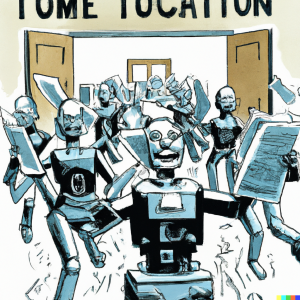
I bring that up because educators have been raising many of the same concerns today about ChatGPT, which can not only write fluid prose on command, but can create poetry and computer code, solve mathematical problems, and seemingly do everything but wipe your nose and tuck you into bed at night. (It will write you a bedtime story if you ask, though.)
In the short term, ChatGPT definitely creates challenges. It drastically weakens approaches and techniques that educators have long used to help students develop foundational skills. It also arrives at a time when instructors are still reeling from the pandemic, struggling with how to draw many disengaged students back into learning, adapting to a new learning management system and new assessment expectations, and, in most disciplines, worrying about the potential effects of lower enrollment.
In the long term, though, we have no choice but to accept artificial intelligence. In doing so, we have an opportunity to develop new types of assignments and assessments that challenge students intellectually and draw on perhaps the biggest advantage we have as educators: our humanity.
Lessons from journalism
That was clearly the lesson the Associated Press learned when it adopted a platform developed by Automated Insights in 2014. That platform analyzes data and creates explanatory articles.
For instance, AP began using the technology to write articles about companies’ quarterly earnings reports, articles that follow a predictable pattern:
The Widget Company on Friday reported earnings of $x million on revenues of $y million, exceeding analyst expectations and sending the stock price up x%.
It later began using the technology to write game stories at basketball tournaments. Within seconds, reporters or editors could make basic stories available electronically, freeing themselves to talk to coaches and players, and create deeper analyses of games.
The AI platform freed business and financial journalists from the drudgery of churning out dozens of rote earnings stories, giving them time to concentrate on more substantial topics. (For a couple of years, I subscribed to an Automated Insights service that turned web analytics into written reports. Those fluidly written reports highlighted key information about site visitors and provided a great way to monitor web traffic. The company eventually stopped offering that service as its corporate clients grew.)
I see the same opportunity in higher education today. ChatGPT and other artificial intelligence platforms will force us to think beyond the formulaic assignments we sometimes use and find new ways to help students write better, think more deeply, and gain skills they will need in their careers.
As Grant Jun Otsuki of Victoria University of Wellington writes in The Conversation: “If we teach students to write things a computer can, then we’re training them for jobs a computer can do, for cheaper.”
Rapid developments in AI may also force higher education to address long-festering questions about the relevance of a college education, a grading system that emphasizes GPA over learning, and a product-driven approach that reduces a diploma to a series of checklists.
So what can we do?
Those issues are for later, though. For many instructors, the pressing question is how to make it through the semester. Here are some suggestions:
Have frank discussions with students. Talk with them about your expectations and how you will view (and grade) assignments generated solely with artificial intelligence. (That writing is often identifiable, but tools like OpenAI Detector and CheckforAI can help.) Emphasize the importance of learning and explain why you are having them complete the assignments you use. Why is your class structured as it is? How will they use the skills they gain? That sort of transparency has always been important, but it is even more so now.
Students intent on cheating will always cheat. Some draw from archives at greek houses, buy papers online or have a friend do the work for them. ChatGPT is just another means of avoiding the work that learning requires. Making learning more apparent will help win over some students, as will flexibility and choices in assignments. This is also a good time to emphasize the importance of human interaction in learning.
Build in reflection. Reflection is an important part of helping students develop their metacognitive skills and helping them learn about their own learning. It can also help them understand how to integrate AI into their learning processes and how they can build and expand on what AI provides. Reflection can also help reinforce academic honesty. Rather than hiding how they completed an assignment, reflection helps students embrace transparency.
Adapt assignments. Create assignments in which students start with ChatGPT and then have discussions about strengths and weaknesses. Have students compare the output from AI writing platforms, critique that output, and then create strategies for building on it and improving it. Anne Bruder offeres additional suggestions in Education Week, Ethan Mollick does the same on his blog, and Anna Mills has created a Google Doc with many ideas (one of a series of documents and curated resources she has made available). Paul Fyfe of North Carolina State provides perhaps the most in-depth take on the use of AI in teaching, having experimented with an earlier version of the ChatGPT model more than a year ago. CTE has also created an annotated bibliography of resources.
We are all adapting to this new environment, and CTE plans additional discussions this semester to help faculty members think through the ramifications of what two NPR hosts said was startlingly futuristic. Those hosts, Greg Rosalsky and Emma Peaslee of NPR’s Planet Money, said that using ChatGPT “has been like getting a peek into the future, a future that not too long ago would have seemed like science fiction.”
To that I would add that the science fiction involves a robot that drops unexpectantly into the middle of town and immediately demonstrates powers that elicit awe, anxiety, and fear in the human population. The robot can’t be sent back, so the humans must find ways to ally with it.
We will be living this story as it unfolds.
How enrollment trends are shaping the university of the future
The latest enrollment report for universities in the Kansas regents system (down 1.5%) seems worth little more than a shrug. Longer term, though, the higher education trends in Kansas will require considerable attention – and action.
Enrollment at the six regents universities has fallen 13.5%, or 10,100 students, since peaking in 2011. That average masks even bigger declines at individual universities: Pittsburg State, down 28.4% since 2011; K-State, down, 21.9%; Emporia State, down 19.7%.
Those make KU’s decline of 11.4% during that period look small, especially with 2022 enrollment basically unchanged since last year and with an 8.2% increase in the number of freshmen this year. The percentage of out-of-state students increased, as well, and the university will no doubt continue to rely on out-of-state students, considering that the rate of Kansas high school students going to in-state public colleges has dropped 10 percentage points, to 44.8%, since 2015.
I’ve written quite a bit about the persistent enrollment challenges in Kansas and around the country. It’s a daunting topic that will require strategic thinking at every level of the university. (Recent cuts at Emporia State offer a glimpse at just how painful this could become.) The rethinking of how we approach higher education must include classes, an area where many instructors have made great improvements but where KU still has considerable work to do in adopting teaching practices that promote student success. It must also include the many structural barriers that Michael Dennin, vice provost for teaching and learning at the University of California, Irvine, spoke about at this year’s Teaching Summit. Those include things like curricula that are difficult for students to navigate and that make assumptions about student capabilities; demands on faculty time; inflexibility in classes and curricula; and a system that provides few incentives for cooperation.
It is through that lens of teaching that I look at some of the areas that stand out in this fall’s enrollment figures.
Women and men
At regents universities, women account for 56% of the overall student population, up about 3 percentage points over five years. Men now make up only 43.8% of the overall student population, down about 3 percentage points over that same period.
KU has a larger percentage of men (46.7%), but that may be the lowest percentage in the university’s history. I can’t say that with certainty, but it is the lowest since at least 1965, the first year for which Analytics, Institutional Research, and Effectiveness provides data.
In news reports from as far back as 1930, universities in Kansas and Missouri reported that their students were primarily men. In October 1960, for instance, The Kansas City Star reported that men outnumbered women 2 to 1 or 3 to 1 on most college campuses in Kansas and Missouri.
In terms of headcount, this year’s group of 11,146 men is the smallest since 1973, the last year the United States had a military draft. Overall headcount enrollment was 18,683 that year, 5,000 fewer than today’s, and men still accounted for 59.1% of students in 1973. Women at KU outnumbered men for the first time in 1988. Their numbers peaked in the early 2000s, but their percentage of total enrollment has grown each year since 2015. They now make up 53.2% of students at KU. That seems to be the highest ever.
The changes at KU have also followed national trends. Young women are more likely to graduate from high school on time and are substantially more likely to earn at least a bachelor’s degree (41% vs. 32% among those age 25 to 34), according to the Brookings Institution. Those numbers vary widely by state, though, as the Brookings table below shows.
Those same differences can be seen in graduate degrees. Since the early 2000s, women have earned about 60% of master’s degrees nationwide, and since 2005-06, more women than men have earned doctorates each year. The most recent totals from the National Center for Education Statistics show that women earn about 54% of Ph.D.s.
Graduation rates
KU rightfully boasted about all-time highs for four-, five-, and six-year graduation rates. The university’s year-over-year retention rate of 84.7% is virtually unchanged from a year ago. That’s also good news.
The not-so-good news is that 1 of every 5 students leaves the university after three semesters, and 1 of every 4 students leaves after two years.
And though the four-year graduation rate has increased nearly 20 points since 2007, it is still a paltry 55%. Over five years, 66.1% of students graduate. That’s a 10-point gain since 2007, but a third of students fail to earn a degree after five or six years. That six-year rate is lower than the average among full-time students at U.S. universities (67.4%) and among students at four-year public institutions (72%).
Graduate enrollment
The number of graduate students at KU has been declining steadily since 1991. At that peak, KU had 7,233 graduate students, according to statistics provided by AIRE. This fall, it has 5,166, a decline of 28.6% since 1991.
That is the smallest number of graduate students the university has had since 1974. This fall’s graduate cohort also makes up the smallest percentage of the overall student population (21.6%) since 1970 (20.2%). Declining numbers of undergraduates nationwide means that the pool of potential graduate students has also been shrinking.
KU’s declines in graduate enrollment run counter to nationwide trends over the last 10, 20 and 30 years, according to the National Center for Education Statistics. Since 1991, graduate enrollment has increased 21% at public universities and 58% at all U.S. universities.
Not surprisingly, the decline in graduate enrollment at KU has meant fewer graduate teaching assistants. The number of GTAs has fallen nearly 18% since 2014, from 1,127 to 927.
Online enrollment
The number of undergraduates taking online or hybrid online courses declined 14.7% this fall compared with Fall 2021. That is the second consecutive yearly decline since online and hybrid enrollment peaked during the pandemic-riddled Fall 2020 term.
Even so, online and hybrid online enrollment among undergraduates this fall was 22% higher than it was in Fall 2019, before the pandemic began. Those students are also taking more online credit hours (39% more than they did in Fall 2019). Those increases are no doubt even higher because of a change in the way KU accounted for online and online hybrid hours. I won’t go into those details, but a footnote on an AIRE-generated table explains the change.
Graduate enrollment in online courses shows a more troubling trend. If we omit the pandemic-inflated figures of 2020 and 2021, the number of students enrolled in graduate and professional courses online has increased 4.2% since Fall 2017, but the number of credit hours has declined nearly 15%.
In other words, there are slightly more online graduate students, but those students are taking fewer classes. The students looking for graduate programs online have also become more choosy, according to the educational consulting organization EAB. Those students often spend months or even years combing through university websites and looking for programs that provide the skills they want but that also waive admissions fees, overlook sometimes spotty undergraduate records, and allow admission without the GRE or other admissions tests.
Shaping the future
Those are just a few of the enrollment trends shaping KU and other universities, and the future will require both cultural and digital change, as John O’Brien argues in Educause.
Universities (KU included) are trying many new approaches as they adapt to shrinking numbers of students and changes among students. Those include more non-credit courses, certificate programs, stackable degrees, and micro-credentials. Some are creating partnerships with area businesses as students focus more urgently on skills they can use in jobs. Others are looking at ways to help students gain credentials in shorter time spans.
At CTE, our programs have helped departments define their curricula in terms of tangible skills, identify ways of making existing courses more appealing to students, create more cohesive curricula, clarify paths to degrees, and connect with more alumni. They have also helped faculty adapt their teaching to a more diverse student body, find ways of drawing on individual differences as a strength rather than a weakness, reinvigorate classes, and hone their teaching.
In all these programs, we have helped build a community that shares ideas and embraces innovation. That community will only grow more important as we navigate changes in enrollment, society, and expectations, and find a meaningful path to the future.
A new school year starts with a bang. (Can it be true?)
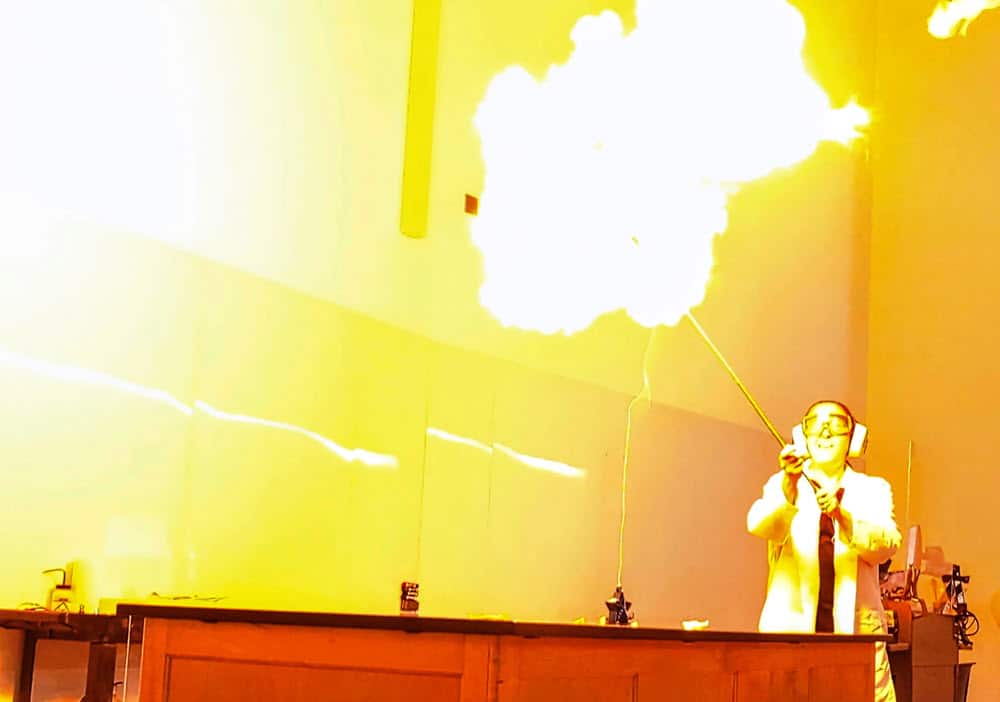
The poor balloon never had a chance.
It was Monday, the first day of fall classes. Lisa Sharpe Elles, assistant teaching professor in chemistry, circled a yellow, hydrogen-filled balloon as it floated above a table in Gray-Little Hall. She told the 200-plus students in Chemistry 130 to cover their ears.
She carefully lifted a flame-tipped wooden rod to the balloon and suddenly pulled back.
She had remembered the lone fool in the front row. That was me, two cameras poised, awaiting a promised explosion.
She grabbed a pair of noise-canceling earmuffs from the floor and told me to put them on. I wasn’t going to argue.
Then, as the clock ticked toward the end of the class, Sharpe Elles held the flame to the balloon again and …
BOOOOOM!!!!!!!
A yellowish-orange fireball flashed, the husk of the balloon plopped to the floor, and the 2022 academic year was off to a cracking start.
An appropriate symbol?
It would have been difficult to predict a flashy start to this school year. The last five pandemic-addled semesters have been more dud than boom. Class attendance was often sparse, students and faculty often seemed encrusted with ennui, and every day felt like the last mile of a marathon in which an invisible force kept moving the finish line farther away.
So far, though, a new spark seems to have spread. Faculty reported that students were eager and engaged on the first day of class, launching into discussions even without prompts to do so. Hallways were once again crowded, with students lingering to chat or finding seats so they could catch up on messages. There were reports of faculty going hoarse as they returned to projecting their voices across classrooms. Even the weather seemed in a different mood, leashing the dog days and instead trotting out mornings that offered a hint of autumn.
At last week’s Teaching Summit, faculty expressed worry about – yet again – trying to engage detached students in low-energy classrooms. If the first two days of Fall 2022 are any indication, though, they may not have much to worry about. It would be foolish to expect that the bubbly spirit of the opening days will last until December. The pandemic has humbled us again and again, melting predictions into foolish if-only-isms.
For a few days, though …
BOOOOOM!!!!!!!
… it feels good to have some hope and maybe even a dream about breaking out the balloons.
Starting another Covid semester amid masks, snowsuits and dragons
As you shake out the post-break cobwebs from your brain and retrain yourself to recognize the half-hidden faces of students, we would like to pass along some exciting news. (Hint: It’s about masks! Yes, masks! Those things that are constantly on your mind – or mouth, or nose, or wherever you are wearing them these days.)
First, though, we’d like to remind you how far you have come.
Just two short years and an ice age ago, Americans were urged to rummage through musty dresser drawers and even mustier basement boxes for old t-shirts that could be tailored into masks. Unfortunately, that Covid-inspired scrounging led to many embarrassing moments as t-shirt owners tried to explain to significant others that they hadn’t really skied naked in Vail (despite the framed certificate of accomplishment), that the dozen threadbare “I’m With Stupid” shirts with pit stains bordering on the sadistic were “just a phase,” and that the odor emanating from all those concert t-shirts was probably just moth balls.
We are glad to put those (uh-hum, hypothetical) memories behind us. Unfortunately, just as we glimpse a hint of light in the Covid dungeon, viral reinforcements dim the view once again. As we continue to learn about the virus, we have no choice but to cast aside our beloved pit-stained t-shirt masks and don N95 respirators. The N95s make us look like we lost a face fight with a snapping turtle, but they block 95% of virus-spreading microdroplets. When combined with a t-shirt mask, they also block 95% of the wearer’s voice.
And now for the exciting news! (Please sit before you read further. We are not responsible for pulled muscles or damaged high-dollar desk do-dads if you make a sudden leap in the throes of excitement.) In the spirit of alternate realities, the Fashion Consultancy Division at CTE has scoured the internet (OK, mostly a site called Old Book Illustrations) for masks that will keep you safe in the classroom even as they show off your trend-setting fashion sensibility!
The selection of masks we have chosen provides protection against everything from sputtering spittle to wayward dragons and significant others who insist on wearing masks made from old t-shirts with sadistic stains and concert odors. They are also guaranteed to ratchet up your views on TikTok. Have a look!

The Snowsuit
This infinitely flexible full-body mask allows wearers to shield as much or as little of themselves as they wish. Having a bad day? Just shape yourself into the ancient demon of your choice and watch the mortals flee. Having a really bad day? Cocoon yourself within an impenetrable ice mound and soothe yourself with bites of premium chocolate between sobs. Faculty meeting droning on? Just grab a hunk from your torso and start lobbing snowballs. Every model of the Snowsuit comes with a carrot-shaped HEPA filter and six gallons of food coloring, offering a teeth-chattering array of fashion options. Wooden limbs and drip pans are sold separately.

The Stormtrooper
This Star Wars-inspired respirator mask, modeled by Shawn Harding, has been available in limited quantities at KU since the beginning of pandemic teaching. It has a fashionable Stormtrooper white cap and jowl protector, and its face plate is guaranteed to withstand the electric pulses of a Jawa ion blaster. (Unfortunately, it is not machine washable.) It has an air hose that doubles as a keyboard cleaner and is attached to the body with an adjustable utility belt with pouches for hand sanitizer, dry erase markers, breath mints, and a lightsaber. It comes with an optional spittle screen (at left in the picture), which adds an extra layer of sound suppressant if students can still hear you speak.

The Full-Body Mask
This well-riveted option was inspired by the Knights of the Round Table, who were early adopters of active learning, and carries a KnRT95 rating. It is guaranteed to protect against all Covid variants, as well as rogue dragons, angry chairs, and colleagues who insist on jousting at faculty meetings. Weighing in at a hefty 60 pounds, it doubles as a muscle toner and diet aid. The faceplate and headgear are welded on once the suit is in place, totally obscuring the wearer’s vision and making removal virtually impossible. It comes with built-in GPS and self-oiling joints. Ornamental tassels provide a festive but non-functioning accessory intended to soften the severity of the armor plating.

The Extraterrestrial
This highly polished beauty will make you look ready to soar into outer space (or maybe to the Land of Oz). The top is made from 100% Covid-proof fashion plate produced in a foil-encased factory deep in the New Mexico desert, not far from a top-secret government facility long-rumored to investigate UFOs and other alien activity. A layered face and neck protector made from recycled barbed wire and old holiday lights completes the ensemble. An optional miniature satellite dish affixes to the dome and allows you to monitor suspicious classroom activity, online discussion boards, and random attempts at mind control. The Extraterrestrial is guaranteed to protect against coffee spills, snarky comments, and typos in PowerPoint slides. It comes with a lightning rod and a recipe for making your own neon-green slime, which can be applied liberally.

The Trojan Dragon
This beast allows you and up to six colleagues to safely teach behind two tons of armor, scales and non-functional wings. It comes with a remote-controlled drawbridge, an optional ladder, and a fire-belching steam whistle that signals the end of class as it burns away any roving virus particles. Because of its height (22 feet, 4 claws), it will not fit through the doorway of any building on campus. It is perfect for remote teaching, though, or for tying up near one of the remaining campus tents and surprising long-missing students who come close enough to investigate. It is fully outfitted with wifi, a microwave oven, a 5,000-meter extension cord, a chamber pot, and takeout menus from every restaurant in Lawrence.
Before you rush out and buy one of these high-fashion masks, we want to remind you to stay safe this semester. You know that, of course, but don’t let your guard down.
Also do what you can to make the semester as meaningful as possible, despite pandemic fatigue, brain fog, and voice-muffling protective gear. We have a wide array of resources on the CTE website and our Flexible Teaching website to help you and inspire you. We and the rest of the CTE staff and Faculty Fellows are also available to help however we can. Don’t be afraid to reach out, even if you are simply worried about whether it is permissible to wear a light-colored mask after Labor Day or whether the ear bands on your mask must always match your shoes. We don’t always have immediate answers, especially about fashion, but we can usually connect you with someone who does.
Now please excuse us. A crowd has gathered around the Trojan Dragon, and we sense an opportunity for learning.
What does higher ed do? Our answer may determine its future.
The future of higher education may very well hinge on our skill as interpreters and communicators.
Too often, though, we never bother to define the terms we use or to help students, parents, and employers understand the purpose and significance of a college education, Ashley Finley told participants at the 2021 KU Teaching Summit last week.

“We develop language as currency,” said Finley, who is vice president for research at the Association of American Colleges and Universities, “and we communicate with each other about a shared meaning without really ever actually defining” what we mean.
Finley is a sociologist who has studied such areas as assessment, high-impact practices, equity in institutional outcomes, and student success. In her presentation at the Teaching Summit, she drew on a recent AAC&U report she wrote titled How College Contributes to Workforce Success, based on a survey of executives and hiring managers at 496 companies. That report contains both good and bad news for colleges and universities.
For instance, 87% of executives and hiring managers said a degree was definitely or probably worth it, but a smaller percentage (67%) said they had a great deal or quite a lot of confidence in higher education. Finley compared those results to a random sample of adults who were asked the same question. Only 60% thought a college degree was worth the time and money.
“We have to get serious about how we’re communicating out what we do,” Finley said. Colleges and universities need to do better at telling their story, she said, not only to employers but to students.
“That explicitness is absolutely for our students,” she said. “They will be our best ambassadors.”
Finley used the term well-rounded as an example of why good communication is important. In academia, we often talk about a need for well-rounded students, but we rarely explain what that means. Students create their own interpretations, though, as Finley showed with a student quote from a focus group:
“I don’t know too many jobs that the job is being well-rounded. You know, it’s not like you’re going to work at Well-Rounded Inc. or something.”
Finley said she appreciated the student’s snark.
“They’ve taken us to task for not defining this thing that we lob in front of them constantly,” Finley said.
She also said the comment was a “good reality check” for educators, in part because of the connection the student made between education and employment.
“They linked it with a job, as if to suggest what you do for me as a person, how I situate myself in a community, and what I learn about a sense of purpose doesn’t have anything to do with the work that I’ll do,” Finley said.
Defining the common good
Another term we often fail to define, Finley said, is common good. She referred to the title of her presentation – Learning for Our Common Good: The Overlapping Skills of Successful Lives and Careers – and said that we all had different definitions of common good and that we rarely shared those definitions with others. She tried to unpack the term.
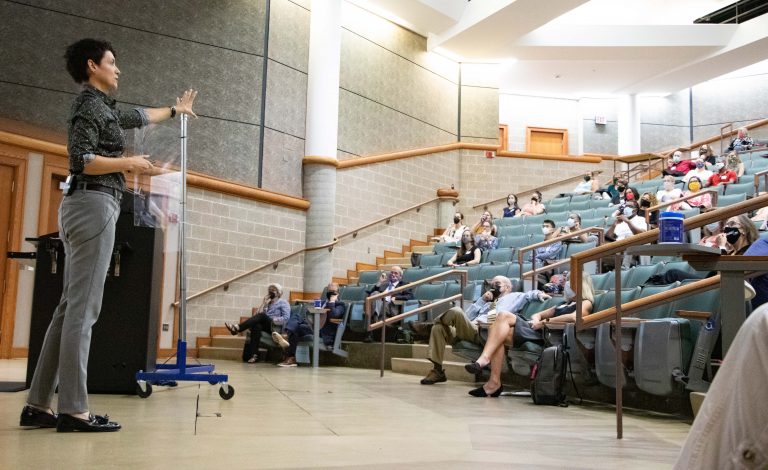
“When we are talking about a common good, we are talking about a greater purpose,” Finley said. “We are talking about how work influences our life, builds a sense of identity, gives our own sense of purpose in the world.”
The common good, she said, is closely tied to the overlapping skills we want students to acquire while they are in college. She asked members of the audience to offer their thoughts on those skills and on how students should be different by the time they graduate. The responses painted a broad picture of aspirations within the academy:
- To critically evaluate what they read and hear
- To gain perspectives on people and stories other than their own
- To be problem-solvers and “realize that there’s a whole big world out there”
- To be more open to diverse people and perspectives
- To try new things without fear of mistakes
- To feel empowered to make the world a better place
We all might add our own flavor and content to those things, Finley said, but they all sound perfectly reasonable for any discipline. She then asked:
“At the end of the day, can we in fact have a common conversation about what matters, and the standards to which we might hold ourselves for students’ learning and for their success?”
The employer view
Articulating a clearer sense of higher education will require us to move past the “false binaries” we often create, Finley said. Those include things like depth vs. breadth, and academic vs. practical skills. They all matter, she said. Higher education should be committed to knowledge, and “equally committed to the ways in which we equip students to have the skills to use knowledge, to create new knowledge, to have an imagination.”
Employers generally see the value in the many skills students gain in college, Finley said. They also value things like mindset, aptitudes, and character. The most recent AAC&U study showed a disconnect between the skills that colleges and universities emphasize and the views employers have on students’ career preparedness. When she and other researchers at AAC&U looked more closely at data from the employer survey, though, they found a stark difference in the perceptions of executives and hiring managers 40 and younger and those 50 and older. Those under 40 are more optimistic about student preparation. They also value different skills.
For instance, younger employers put considerably more emphasis on the need for critical thinking, leadership skills, empathy, and an ability to work with numbers and statistics. More broadly, they are far more likely than their older colleagues to say that a college education should encourage engagement in communities, foster a sense of social justice, focus on global issues, and emphasize the liberal arts and sciences.
“This felt like a game-changer to us,” Finley said, adding: “Hello, liberal arts. And hello, community-based learning.”
A need for articulation
If the views of younger employers offered optimism about the core values of higher education, another study that Finley brought up muddied the picture. That study showed a growing gap between the number of campuses that say they have learning outcomes and the number of students who are aware of those outcomes. She called that a “reality check of how our own communication is going.”
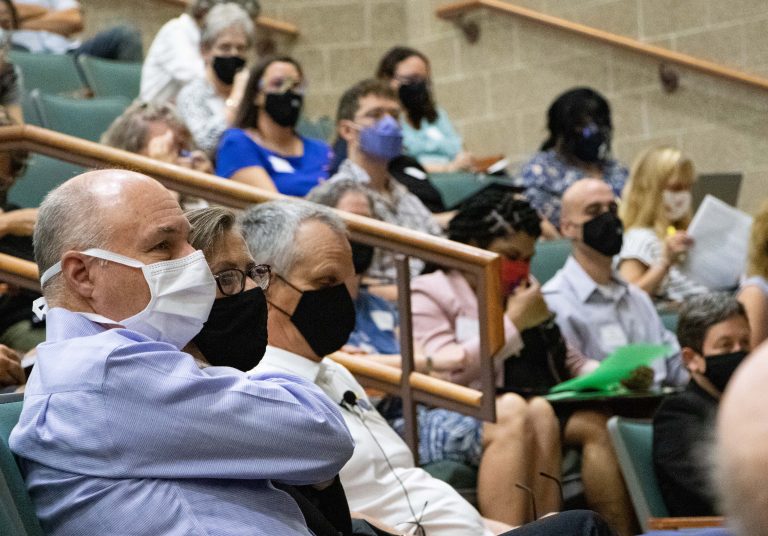
We have to increase the visibility of our core goals, Finley said. We have to do a better job of communicating, and we have to do a better job of projecting the type of outcomes we care about. This will require a nuanced approach to career preparation, she said, and must help students connect the dots among the courses they take and the experience they gain while in college. By the time students graduate, they should be different, she said.
“It’s not just about what they know and can do; it’s about who they are. And should they be able to persist through failure? Should they be a little more resilient? Should they have a sense of what it means to flourish?”
The answer to all of those is yes, of course, and Finley was optimistic that faculty could work through the many challenges before them.
“Good teachers are good learners,” Finley said. “You have to be humble to learn something new, and I hope that is always a point of connection we have with our students.”
* * * * * *
You will find a recording of Finley’s presentation at the Teaching Summit on the CTE website.
A weary campus asks: What happened to spring break?
As we near the halfway point of what we hope will be the final semester of remote everything, we at CTE encourage you to take a collective breath, put your feet up, and read an important news story you might have missed.
We can’t guarantee a happy ending. Then again, that all depends on what you consider happy.
Consider it the week that might have been.
LAWRENCE, Kan. (Coronavirus News Service) – Thousands of bleary-eyed students and frazzled faculty members staggered through the University of Kansas campus this week in a desperate search for spring break. For most, the search ended blissfully in unscheduled naps.
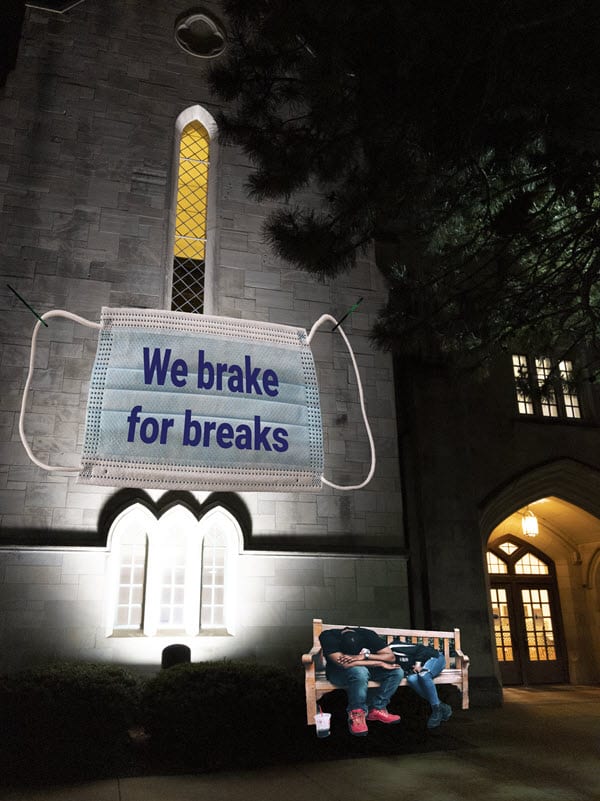
It was estimated to be the largest socially distanced gathering in this once-vibrant college town since the physics department hosted the Oppenheimer Memorial Baked Bean Blastoff in 1968. Masks were mandatory at that event, too.
Students dressed in flip-flops and neon yellow Give Me a Break! T-shirts crawled through bushes, wandered in circles around Wescoe Beach, and waded into Potter Lake looking for anything that resembled a break. Several dozen freshmen hopped on one foot and held open plastic shopping bags beneath trees in Marvin Grove, emulating a viral TikTok video that demonstrated “the proper method of catching a break.” The students said they had never actually seen a spring break, though, and admitted that they wouldn’t know one even if it fell into their bags.
At Watson and Anschutz Libraries, librarians dragging beach towels and wearing We Brake for Break masks scoured the stacks. Faculty members spent hours squinting into tea-stained mugs for clues. One distraught professor was found wrapped in paper towels in a Budig Hall rest room, sobbing something that sounded like “Rosebud.” Only the anthropology faculty seemed to understand the significance of the strange occurrences. One professor proclaimed it “the greatest day since Goodall picked up a pair of binoculars, or maybe since Geertz tried to nail jelly to a wall.”
Mass napping and an emergency task force
At the corner of Crescent Road and Naismith Drive, employees of McLain’s Market handed out Break Break Breakety Break Survival Kits, which were really gallon buckets of industrial-strength coffee beans and instructions that read: “Stuff as many beans into mouth as possible. Don’t try to talk. Just think happy thoughts.”
On the other side of campus, students rubbed fake beach sand into their hair and twirled tiny umbrellas between their fingers as they staked out socially distanced plots on the lawn near Watson Library, propped themselves up along the foundation of Fraser Hall, and took seats inside a tent outside Stauffer-Flint Hall. The muted stimulation proved overpowering, and most resorted to napping wherever they could find a spot.
When asked whether anyone had found spring break, most students just gave confused stares and nodded off. One student who seemed to have been appointed the group’s media representative issued a terse statement:
“Huh?”
In a press release, the interim assistant sub-vice chancellor for calendar efficiency said that all available employees in that one-person office were “diligently searching for spring break.”
“I think we canceled break, but I’m not sure,” the interim assistant sub-vice chancellor said. “We were all really tired when we talked about that last year, and everybody just wanted to get off Zoom. Whatever we did seemed like a good idea at the time.”
An emergency task force has been formed to study the problem.
The Center for Teaching Excellence responded to the crisis by sending out suggestions to beleaguered instructors. Among them were:
Allow catch-up time. Jennifer Delgado in physics created a “spring pause” for her classes, holding off on new assignments and allowing students to catch up on previous work. Lisa McLendon in journalism and mass communications did something similar, creating a “catch-up week” in her classes. Those seemingly small actions can offer students some temporary relief and buoy spirits.
Create lighthearted activities. Things like learning games, a question of the day, and self-care activities can help pull students from a midterm slumber and give classes a fresh focus. Also consider activities like scavenger hunts, which give students an opportunity to get away from their screens. CTE’s Flexible Teaching Guide offers many other suggestions.
Acknowledge the challenges. Let students know that you understand the challenges that a year of social distancing and mostly remote learning have created. Encourage them to take some time for themselves, give them permission to nap (when they aren’t in class), and find ways to help them interact. For instance, create random breakout rooms on Zoom or take a few minutes in class and encourage students to share what they wish they could be doing if they had an actual spring break. (Dreaming is a good thing.)
Take care of yourself. Students pick up on your moods. If you are sluggish and cranky, your students will be, too. So give yourself permission to get away you’re your computer. Visit the Spencer Museum of Art. Talk a walk through downtown Lawrence. Explore a part of campus you haven’t seen in a while. Visit the Baker Wetlands. Or just stroll through your neighborhood and look for signs of spring. Any of those things can lighten your mood and help make class go more smoothly for everyone.
When will break return?
Spring break is expected to return next year, although the interim assistant sub-vice chancellor for calendar efficiency said departments and schools had been asked to plan for three contingencies: Breaks that would last either 1 day; 1 hour, or 5 minutes.
When told that a five-minute spring break seemed ludicrous, the interim assistant sub-vice chancellor shrugged and said:
“We prefer to think of it as an abbreviated policy option necessitated by the constraints of time. You can call it whatever you want.”
(Note: This article does not reflect the views of KU, CTE, KU Libraries, the physics department, the anthropology department, McLain’s Market, the Office of the Interim Assistant Sub-Vice Chancellor for Calendar Efficiency, or anyone else you can think of. As far as we know, it’s not even true – except for the part about everyone missing spring break. Zzzzzz.)
GPAs at KU rose considerably in spring, a semester with an asterisk
Grade point averages for University of Kansas undergraduates rose an average of 8.4% in the spring as instructors offered more flexibility after a shift to remote teaching and more students took advantage of pass/fail grade options.
Men saw a slightly larger increase in GPAs than women did (9.1% vs. 7.9%), although women’s GPAs (3.3) were already higher than men’s (3.09) before the coronavirus pandemic. Freshmen had a larger increase in GPAs in the spring (10.7% for men; 10.5% for women). As with undergraduates as a whole, freshman women (3.05) already had higher GPAs than their male counterparts (2.8).
GPAs for graduate students rose 1.3%, to 3.86 from 3.81, and have remained within a small range over the past decade.
Compassion, accommodations and concern
Those GPA increases are hardly a surprise, and many aspects of the semester will carry an asterisk to explain the dramatic changes that took place during the pandemic.
“Flexibility” became the guiding principle as the world figured out how to live amid a deadly virus. For KU and other colleges and universities, that flexibility included adaptations to class format as campuses were closed, an extended window for withdrawal from classes, requests to avoid use of attendance as a factor in grades. broader use of pass/fail course options, additional time for online exams, and widespread pleas for compassion in grading. There were also concerns, many of which were validated, that some students were cheating during remote exams.
All of those factors no doubt played a role in pushing up grade point averages in the spring. Among the schools at KU, spring grades rose the most in architecture and design (11.3%), followed by engineering (10.6%), law (9.9%), liberal arts and sciences (9.8%), pharmacy (8.1%) and journalism and mass communications (6.9%). Schools with smaller increases already had GPAs higher than the university average: business, education, music, and social welfare. (See the chart below.)
The meaning of GPAs
I have no national data to compare with KU’s data, and I offer the statistics mostly as a point of interest.
I was surprised by how high the average GPA was in some fields even before spring of this year, but that could be the result of many things (including better student work and more openness to rewarding good work). Between 2010 and 2019, the average GPA at KU increased about 2%, although it rose the most in engineering (5.9%), liberal arts and sciences (5.9%), and music (3.8%).
When I look at GPAs in this context, though, I can’t help but wonder about bigger questions:
- What does a grade mean?
- What should it represent?
- Have grades outlived their usefulness? (GPAs are tied to credit hours, which have little or no meaning in a world of online and hybrid courses.)
- How are grades connected to actual learning?
In a book chapter titled “The Dangerous Myth of Grade Inflation,” Alfie Kohn says grades are too often seen in terms of a “marketplace analogy.” He asks: “Is the professor’s job to rate students like blenders for the convenience of corporations, or to offer feedback that will help students learn more skillfully and enthusiastically?”
In other words, how can we think less about grades and more about learning?
A look behind KU’s fall enrollment numbers
The headlines about KU’s fall enrollment sounded much like a Minnesotan’s assessment of winter: It could be worse.
Indeed it could have been, given the uncertainties brought on by the coronavirus and rumblings among students that they might sit out the year if their courses were online.
Depending on how you measure, enrollment on the Lawrence and Edwards campuses fell either 2.7% (headcount) or 3.4% (full-time equivalency) this fall. That is about the same as the nationwide average (-3%) but slightly worse than the average decline of 1.4% at four-year public universities, according to data from the National Student Clearinghouse Research Center.
A single year’s top-level data provides only a limited view of a much bigger picture. To better understand this year’s enrollment, we need to take a broader and deeper look in terms of geography, history and demographics. Here’s what I’m seeing in data from Academics and Analytical Research, the Kansas Board of Regents and some other sources.
Enrollment declines throughout the state
KU was hardly alone in dealing with the sting of an enrollment decline. Among regents universities, Pittsburg State had the largest decline in enrollment (-5.9%), followed by K-State (-5.1%), KU, Wichita State (-3.1%), Fort Hays State (-2.8%) and Emporia State (-2.3%).
As a whole, the state’s community colleges fared far worse, with a combined drop of 11.7%, about 2 percentage points higher than the national average. Johnson County Community College had the largest decline (18.7%). Enrollment at JCCC has fallen 23.5% over the past five years, a troubling statistic given KU’s proximity and institutional connections to JCCC. During that same period, enrollment at the state’s 19 community colleges has fallen by an average of 18.6%, according to regents statistics. Eight of those colleges recorded declines of more than 20%.
Kansas is one of 11 states where the decline in undergraduate enrollment exceeded the national average, according to the National Student Clearinghouse Research Center, Others include Missouri, Arkansas, Illinois, Indiana and Florida. Only five states recorded increases in undergraduate enrollment, including Nebraska.
Putting the trends into perspective
Over the past 50 years, college and university enrollment has reflected broader societal trends that made a college degree a sought-after goal. As numbers trend downward, though, enrollment figures also highlight the looming challenges that most of higher education faces.
From the 1960s to the 1980s, undergraduate enrollment rose steadily as baby boomers entered college in larger percentages than previous generations. The number of colleges – especially community colleges – grew, providing more opportunities for students to seek a degree. Federal aid, including low-interest loans, also expanded, as the federal government promoted the importance of education and invested in university research. A college degree became the minimum standard for many jobs and led to higher salaries over a degree holder’s lifetime.

Those trends are certainly reflected in KU’s enrollment data. Between 1965 and 1991, headcount enrollment at KU nearly doubled. (See the chart below.) It declined after a recession in the early 1990s, but rose again in the early 2000s, peaking in 2008 during the recession. It declined until 2012, stabilized briefly, and then began another decline, one that is very likely to continue given a declining school population. K-12 enrollment in Kansas peaked in the 2014-15 school year, according to Kansas State Board of Education data. It is projected to start a significant decline in the late 2020s, largely because of a decline in birth rates after the recession of 2007-08. Since peaking in 2007, birth rates in Kansas have fallen 13.6%. (See the chart above with the most recent data available from the state.)
In another disturbing trend, the number of Kansas students coming to KU has dropped 17.7% since 2011. (It was down 2.9% this year.) The university has attracted more out-of-state students, who make up about 40% of the student population, but the trends among Kansas students are bleak.
KU attracts the largest number of students from Johnson County, which accounts for 28.3% of the university’s enrollment. The number of students from Johnson County has fallen 7.3% over the past decade. That is far less than the drop in students from other counties from which the university draws the most students: Douglas (-25.2% since 2011), Sedgwick (-27.1%), Shawnee (-26%). Declines in others aren’t as dramatic but are still troubling: Wyandotte (-9.8%), Leavenworth (-3.3%) and Miami (-3.2%). Others are far worse: Saline (-30.5%), Riley (45.1%), Reno (42.3%).
More Hispanic students, fewer international students
One of the most interesting developments I saw in enrollment this fall was that for the first time in decades, the number of Hispanic students at KU exceeded the number of international students. (See the chart below.)
This reflects two major trends. First the Hispanic population of Kansas has grown more than 70% since 2000. Hispanics now make up more than 12% of the Kansas population and 18.5% of the U.S. population. The number of Hispanic students at KU rose 3.3% this year and has risen nearly every year since the mid-1980s.
Meanwhile, the Trump administration has taken a less-than-welcoming stance toward international students and immigration in general. That, combined with a global pandemic and lack of a coherent plan for combatting the pandemic, has sent international enrollment at U.S. universities plummeting. By one estimate, the number of new international students at U.S. universities could soon reach the lowest level since World War II.
As KU reported, the number of international students at the university declined more than 18% this fall. That decline is greater than the 12.5% decline in international students at public four-year universities, according to data from the National Student Clearinghouse.
Other trends worth noting
- A continuing rise in female students. The number of female students on the Lawrence campus continued to exceed the number of male students. The number of male students fell 1.4% this year, compared with 0.5% for female students, and has fallen 11% since 2011. For the first time in at least a decade, the number of women who transferred to KU was larger than the number of men who transferred. Men now make up 47.5% of the KU student population. Nationally, the number of women seeking college degrees surpassed the number of men seeking degrees in 1979. That was the first time since World War II that more women than men attended college, according to the National Center for Education Statistics. In the 40 years since then, the gap has only increased, as it did again this year. Sixty-seven KU students did not identify as male or female this year. That was similar to the 73 in 2018 but down from 509 in 2019, suggesting that last year’s spike was intended as statement against the reporting system, primarily by graduate students.
- Another decline in graduate enrollment. The number of graduate students on the Lawrence campus fell 2.2% this year, compared with an increase of 4.7% at public four-year universities. That is the fourth consecutive year of declines. The number of graduate students has fallen 12.5% since 2011. Graduate enrollment at KU peaked in 1991 and has declined 25% since then. (See the chart labeled University of Kansas Enrollment, 1965-2020.)
- Another increase in part-time enrollment. I noted last year that the number of part-time students had been rising steadily. That number rose 6.8% again this year and is 18.9% higher than it was in 2011. Part-time students now account for 17.7% of the student body. That isn’t necessarily bad, given the university’s agreement to provide dual enrollment classes with the Lawrence Public School District. It is concerning, though, given that more students nationally are choosing to pursue their degrees part time. That gives them more flexibility to work but delays graduation. In what I see as a related trend, the number of non-degree-seeking students, although still small at 445, has increased more than 200% since 2011.
- Some perspective on freshman enrollment. As the university reported, the number of incoming freshmen declined 7.2% this fall. Since a peak in 2016, the number of incoming freshmen has declined by 9.5%. Even so, the total this year is 7% above that of 2011.
- A continuing drop in transfer students. The transfer rate to KU can only be described as glum. The number of new transfers to the Lawrence and Edwards campuses was down 8.2% this year and the total fell below 1,000 students for this first time in more than a decade. The number of transfer students has fallen 32.7% since 2011, following the downward trend in community college enrollment.
- Large growth from a few states. Since 2011, the number of students from seven states has increased by an average of 45%: Missouri (+40%), Illinois (+46%), Colorado (+47%), Nebraska (+76%), California (+33%), Oklahoma (+61%), Wisconsin (+42%). Collectively, students from those states (by headcount) make up 22% of the student body at the Lawrence and Edwards campuses. KU also attracts a considerable number of students from Texas and Minnesota, although those numbers have grown only slightly over the past 10 years.
- Business continues to grow. Even as overall university enrollment declined, undergraduate enrollment in the School of Business rose 7.9% this year and has grown 131% since 2011. Enrollment in engineering declined 2.2% this year but is up 31.6% since 2011. Enrollment in liberal arts and sciences continues to sag. Undergraduate enrollment in the College fell 4.8% this year and is down 21% since 2011. Graduate enrollment was down only slightly less. Even so, the College of Liberal Arts and Sciences still has nearly five times as many students as either business or engineering.
Where do we go from here?
Demographically over the past decade, the KU student population has become more Hispanic, more multiethnic and more female but less Kansan and less international. It is still predominantly white (68%) and is more oriented toward business and engineering. It has grown younger over the past decade, with students 22 and younger making up about 70% of the student body, compared with about 64% in 2011.
The university has about 1,500 fewer students than it did a decade ago. It has a slightly larger percentage of undergraduate students than at the start of the decade, although the proportion of undergraduates to graduate students has remained within a small range since 2000. Even so, graduate enrollment has fallen more than 14% since 2011.
I’ve written frequently about the challenges higher education faces, about the need to understand our students better, to innovate, to emphasize the human element of teaching and learning, to think about what we are preparing our students to do, and to provide a clearer sense of what higher education provides. This year’s enrollment figures simply reinforce all of that.
This is the fourth consecutive year of enrollment decline at KU and the ninth consecutive decline at the six regents universities. Those declines have become increasingly painful because of growing reliance on tuition and fees to pay the bills. In Fiscal 2019, tuition and fees accounted for more than 30% of the Lawrence campus’s $900 million in revenue. State appropriations accounted for just over 15%. In other words, students pay about $2 for every $1 the state provides. That is unlikely to improve in the foreseeable future, especially with the state facing a projected $1.5 billion shortfall in the current fiscal year.
In other words, the future of the university depends greatly on enrollment. Enrollment depends greatly on the value that students and parents see in KU. It’s up to all of us to make sure they do indeed understand that value.
We interrupt your malaise with this message from Abraham Lincoln
Dear sleep deprived colleagues,
We ask you to take a few minutes to consider these not-so-solemn words. Full disclosure: You have all been muted for the duration of this speech.

Four score and 700 years ago (or so it seems), the coronavirus brought forth on this campus a new semester, conceived in haste, cloaked in masks, and dedicated to the proposition that all Zoom meetings suck the life from us equally.
Now we are engaged in a great civil chore, testing whether this faculty and these students, or any faculty and students so distanced and so sapped of energy and so deprived of even a hint of a break, can long endure. We are met within a great white tent that reminds us every day of that chore. We have come to dedicate a portion of that tent as a final resting place for the remnants of normalcy we have all surrendered, six feet apart and clutching personal squeeze bottles of hand sanitizer, in so that this university might live.
But, in a larger sense, we cannot dedicate – we cannot commiserate with – we cannot even take a nap within – this tent. The brave instructors and students, mildly coherent or fully brain-dead, who struggled here, have already commiserated far above our poor power to whine or snap. The world will little note, nor long remember, what we say here, but it can never forget that this semester was, without doubt, the longest and most challenging in … in … like forever, for crying out loud.
It is for us, the mildly conscious and highly caffeinated martyrs of alternating cohorts, to be dedicated here to the unfinished work that seems fated never to be nobly advanced. It is rather for us to be here dedicated to the great task remaining before us – coasting 500 miles, uphill, on a single wheel, to the end of the semester – that from these husks of human beings all around us we take increased devotion to that cause for which they gave their last full measure of self-respect – that we here highly resolve that these brain-dead shall not have burned out in vain – that this university, upon a hill, shall birth a new never-ending semester – and that education of the remote, by the remote, for the remote, shall not perish from the earth.
You may unmute yourself now.
Now take a deep breath (and a nap if you need one). You can make it through the rest of the semester. — Doug Ward
P.S. Don’t forget to visit the Center for Teaching Excellence’s Flexible Teaching Guide for ideas and inspiration.
40 days (and 40 nights?) of teaching in confinement: A diary
The shift to remote teaching this semester quickly became a form of torture by isolation inflicted upon us by microscopic organisms. There has to be a bright spot somewhere, though. Right?
13 days until isolation. A carefully planned list of 1,368 VERY IMPORTANT THINGS to do during spring break dissolves before my eyes as I am enlisted to help create a website on remote teaching. In a university conference room, a dozen people stare at laptop computers. Half-a-dozen others peer out like the Brady Bunch from a videoconference screen running Zoom. I fear this is a premonition.
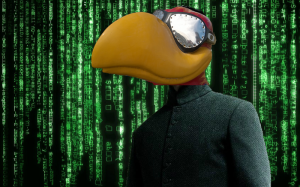
10 days until isolation. I ponder the enormity of the task before us. All university classes will shift to a remote format. Thousands of people will hook up their brains to an electronic network, abandon a corporeal existence, and struggle to make sense of a new reality. Wait. I’ve seen that movie.
Two days until isolation. At my last physical meeting on campus, I glance at my feet and realize I am wearing two different kinds of boots. A colleague snickers. Then everyone snickers. “We’re not really laughing at you,” she says. “It’s just …” I try to look at the bright side. At least I put my boots on the right feet.
One day until isolation. I spend an hour digging through drawers and cabinets for anything I might need for working at home. I leave the office with a backpack strapped to my back, three large bags dangling from my hands and a whiteboard tucked beneath my arm. I can’t shake the feeling that I have forgotten something. My phone! Six feet behind me, the office door slams shut.
Isolation Day 1. A fog settled over Lawrence during the night. A perfect setting for the first day of remote classes. A bright spot: Candy Crush announces unlimited lives all week long.
Isolation Day 2. Laptop in lap, I sit in my living room and join a Zoom meeting. On screen, a colleague lounges on a tropical beach at an undisclosed location. Oh, wait. That’s a fake background. He probably just did that to get attention. I roll my eyes.

Isolation Day 3. I scour the web for a picture of the Tardis, the police call box that the Doctor uses to traverse time and space in Doctor Who. During a time of social isolation, economic turmoil and general uncertainty, I can go anywhere and any time. Such symbolism! I set the image of the Tardis as my background in Zoom.
Isolation Day 4. “You’ll have to tell us what that background is,” a colleague says at the beginning of a Zoom meeting. Inside, part of me dies.
Isolation Day 5. I change my Zoom background to the bridge of the Starship Enterprise.

Isolation Day 6. I need to get groceries. I fashion a mask from a blue bandana. Then I put pull my leather outback hat down low. I giggle. I tell my wife I look like I’m getting ready to rob a stagecoach. My wife rolls her eyes. I shrug and change to a red ballcap. At the grocery store, everyone stays back well more than six feet.
Isolation Day 7. My personal care appointments fall like dominos. My dental appointment, canceled. My eye appointment, canceled. My haircut, canceled. I consider whether my out-of-control hair will eventually cover my toothless mouth. I decide it won’t matter because I won’t be able to see.
Isolation Day 8. Growing weary of working in the living room, I excavate a corner of my sons’ former bedroom for a workspace. It feels strangely familiar. A bed next to me is heaped with books, cast-off clothes, pillows, blankets, a laundry basket filled with hangers and some boxes filled with – is that a muskrat hide? I feel like I have taken refuge in a dorm room. Or is it my office?
Isolation Day 9. I gleefully plug in a smart speaker in the excavated spare bedroom I have turned into a work area. My wife unplugged the speaker in the main part of the house months ago because she thought I was always talking to myself. Now, with the door closed, I can ask it anything. Anything! I think long and hard. “Hey, Cortana. What’s the weather?” Like I really need to know.
Isolation Day 10. I set up the portable whiteboard I retrieved from my office and scrawl a list of VERY IMPORTANT THINGS in green marker. Then I brace for ultra-productivity. I envision a self-help book about VERY IMPORTANT THINGS and a tour as a motivational speaker. “How do you do it?” people will ask. I will simply hold up a green marker and say … Oh, no. Does it really say PERMANENT?
Isolation Day 11. After six hours of Zoom meetings, my laptop has fused to my lap, my headset has fused to my ears, my eyeballs hang limp, and I feel as if I have traveled into another dimension. I change my Zoom background to a glacier lagoon from Iceland and head to the refrigerator for a beer. A puddle has appeared in front of the refrigerator. Either it needs to be defrosted or it has developed incontinence. Note to self: Ask Cortana.

Isolation Day 12. As I venture outside, I find that the 5-year-old girl next door has created a Fairy Garden in her front lawn. I know because she has planted a sign. I take a picture, add images of fairies and send it to her mom. The message I get back: Mom likes it, but the 5-year-old wants me to know that the fairies in my picture don’t look real. I am unable to work for the rest of the day.
Isolation Day 13. Students mention feeling disconnected from their classes. I feel disconnected from the students. So I set up office hours on Zoom. No one shows up. Note to self: Remote teaching is exactly like in-person teaching.
Isolation Day 14. A green arrow appears on the sidewalk on our block. It points south. I sense symbolism.
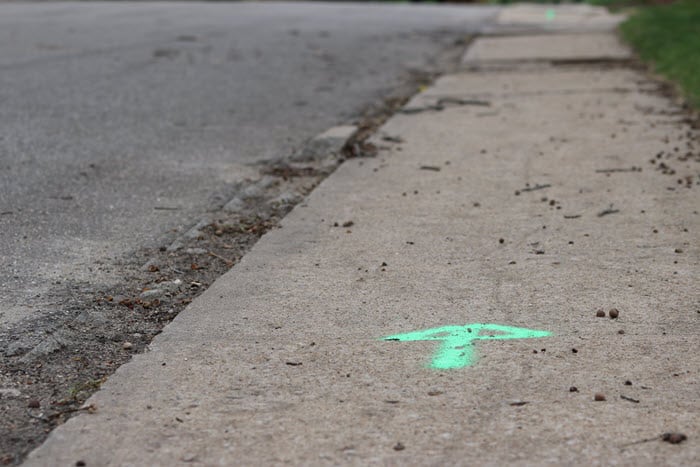
Isolation Day 15. I walk to the end of the driveway and retrieve the morning newspaper. It’s still dark. The streets are quiet. The moon glows against patchy clouds. Birds chatter. Trees rustle. Tulips are blooming. So are the redbuds. Well, I got in a nature walk today.
Isolation Day 16. TikTok shows video after video of cats and dogs jumping over rolls of toilet paper that their owners have stacked in doorways. I am not making this up. One cat hurdles what must be at least 40 rolls of toilet paper. I look in our bathroom cabinet. Three rolls. I stack them in the doorway and hop over them. Then I put them back before my wife asks me whether I have lost my mind.
Isolation Day 17. I have worn nothing but slippers for six days. Why do I feel guilty?
Isolation Day 18. I’m afraid people will get the wrong idea. I didn’t literally mean that I wear nothing but slippers. I meant that I wear nothing but slippers on my feet. On my feet! I’m sure that’s right. If I were wrong, someone on Zoom would have told me. Wouldn’t they?
Isolation Day 19. I reach the ignominious total of 50 hours on Zoom since isolation began. I wiggle my toes in celebration.
Isolation Day 20. In an apparent act of defiance, a plastic bolt that holds down one side of the toilet seat snaps and flies into the wall. I stare. I shake my head. Then I put the lid down gently. I can’t deal with this right now.
Isolation Day 21. I have ignored my online to-do list for 18 straight days. Three feet away, the green list of VERY IMPORTANT THINGS on the whiteboard seems to animate into an evil grin. Or maybe it’s my imagination. I’m never sure anymore.
Isolation Day 22. In a webinar: Flatten the curve. In email: Flatten the curve. In the newspaper: Flatten the curve. On the radio: Flatten the curve. In my dreams: Flatten the curve. For posterity: My brain has already flattened.
Isolation Day 23. No matter how much grading I do, the amount of unread student work seems to grow. So does the strain on my back. I lapse into a daydream about Sherpas, loaded down with gear, guiding hikers on a treacherous mountain trail. I shiver and blink. What was I doing? I can’t remember. I shut down my computer.
Isolation Day 24. During a webinar, the chancellor says that more than 90% of KU employees are now working remotely. He says this while wearing a suit and tie. Does he really a suit and tie while he works from home? I’ve worn the same shirt for four days. I have absolutely no interest in wearing a tie.
Isolation Day 25. The whiteboard on which I wrote VERY IMPORTANT THINGS torments me. Somehow, none of those things are getting done, even though I used green ink. I wonder if red would help. I embark on a fruitless search for a red marker.
Isolation Day 26. My neighbor the musician has taken up drumming. I much preferred the guitar.
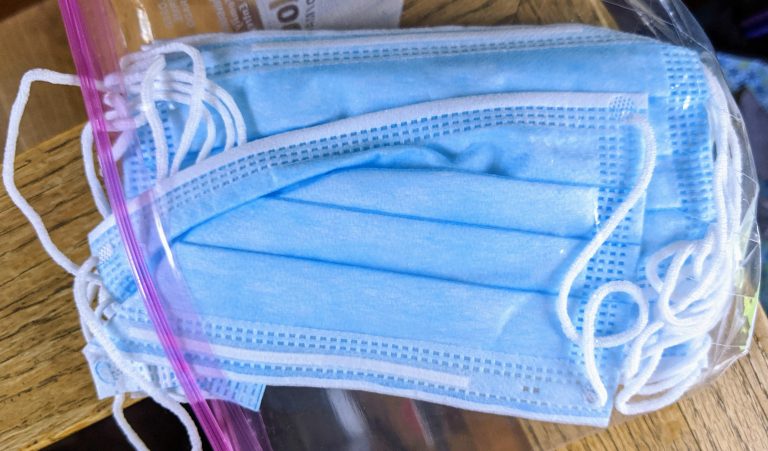
Isolation Day 27. A large brown envelope arrives from a friend in Macau. Inside, I find a pack of disposable surgical masks. Even though my friend advised me in January to stock up on face masks and hand sanitizer, I find no “I told you so” note inside the envelope. I send a text thanking him and telling him I recently found a 32-ounce bottle of hand sanitizer selling for $19. “Ah, capitalism,” he responds.
Isolation Day 28. During a meeting, I realize that Zoom spelled backward is mooZ. The meeting suddenly takes on a new meaning.
Isolation Day 29. I place an online order at Brits, a downtown store that sells all things British. (I don’t have to explain to anyone there what the Tardis is.) I have a hankering for digestives. They know what those are, too. The owner calls me. “I’ll leave the bag on the front step and run,” she says. It’s like having a May basket delivered. Or maybe she just saw the picture of me in the mask.
Isolation Day 30. Bzzzzzz. My Fitbit (bzzzzzzz) taunts me. Bzzzzzz. Time to get up and move, it says on the screen. It shows a perky stick figure stretching and leaping. “OK, where am I supposed to go?” I snarl. My smart speaker blinks blue. “I’m sorry. I’m afraid I didn’t catch that.”
Isolation Day 31. I read that anxiety from being shut in during the coronavirus can affect mood, work habits, even concentration. I’m not sure I b
Isolation Day 32. I assess the contents of the refrigerator: five lemons, a dribble of almond milk, a container of yogurt, a bottle of beer, a bottle of salad dressing, a bottle of ketchup and two plastic containers of unknown substances. I stare dolefully. I make a list. That’s all. I just make a list.
Isolation Day 33. I take my list and drive to the grocery store. I struggle to keep my mask on. I crane my neck, bob my head and push my nose upward like a bird drinking water. The cashier tries not to notice. Instead, she points at two giant containers of animal crackers on the conveyer belt. “How are your children doing amid this chaos?” she asks. Children? Oh, I say. One lives in Seattle. The other lives in Ontario. She looks again at the containers of animal crackers. I bob my head all the way to the exit.
Isolation Day 34. I woke up 14 times last night. I couldn’t stop bobbing my head.
Isolation Day 35. It’s the middle of the night. As I lift the toilet seat, it leaps from the single remaining rod securing it to the bowl. I lurch to catch it, bobbling the seat and jamming my shin into the bowl. The lid whacks the tank and lands like a horseshoe onto a plunger beside the bowl. Ringer! The seat whacks the floor with the force of a sledgehammer. “Are you all right?” my wife calls from the bedroom. I’m not sure how to answer. (Note to reader: You may question the use of leaps and sledgehammer in describing a toilet seat. Just remember. It is the middle of the night.)
Isolation Day 36. If I multiply the number of minutes I spend in Zoom meetings by the number of participants in those meetings, it equals the number of new email messages I receive during those calls.
Zm x Zp = ∞
I think I’m on to something big.
Isolation Day 37. The price of the Fake Me a Call Pro app has dropped to $6.49. It offers an extensive list of features, including a “custom fake call voice” and a “huge custom list of fake callers.” I imagine millions of people locked inside and fake-calling themselves. I’m not going to sleep again tonight. Am I?
Isolation Day 38. I stare at the faces in a Zoom meeting. Egads! Who is that squinty, raggedy-looking guy who desperately needs a haircut? Oh, wait. That’s me. Note to self: Apologize to colleagues for the visual fright I’ve caused.
Isolation Day 39. I have now logged more than 100 hours of Zoom meetings since seclusion began. I change my Zoom background back to the Tardis. Then I write “Change Zoom background” in green on the taunting whiteboard. Then I cross it out. For the first time in a month, I feel a sense of accomplishment.
Isolation Day Whatever. I finish grading. I should feel excited. I should feel so excited that I perform a hip-swaying dance in my slippers and post it on TikTok. Instead, I put on a mask, go to the hardware store and buy a toilet seat. Sigh. Now I have to install it.